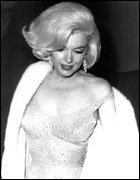This is the Girl :
Hollywood Women, Myths and Surrealism
 |
|
|
|
David Lynch is a post-modern director. The
post-modern elements of pastiche, nostalgia and role play
are all engaged in Mulholland Drive. Notably, Lynch
broadly references the iconography of Golden Age, post-war
and fifties/sixties Hollywood, reaffirming that the iconic
power and corruption of Hollywood remain terrifically seductive.
The anachronistic images, sounds and characters of Mulholland
allude to a lush and exploitative past while they haunt contemporary
tales of failure and self-fragmentation. In the post-war years
in particular, perhaps, Hollywood reflected and reinforced
the ideological mastery of American women as it exploited
its own chosen ideal women. Such violent conventions and practices
often had destructive psychological consequences on Hollywood
women. It is intriguing, and of course tragic, that the lives
of some of the greatest female Hollywood stars - such as Frances
Farmer, Dorothy Dandridge and Marilyn Monroe - were marked
by despair and madness as they were exploited within and without
the system. The actress, the ultimate object of desire, is
sullied and discarded. Interestingly, it has been reported
(1) that Lynch was to adapt Anthony Summer’s Goddess (1985),
an historical account of Marilyn Monroe’s death which suggests
that Marilyn did not commit suicide but was romantically linked
to the Kennedy brothers and murdered by powerful forces. Of
course, the actress in twentieth century Western culture was
frequently celebrated in the role of modern concubine to men
of power from Goebbels to Kennedy as the actress in the 19th
century was stigmatised as a kind of prostitute. Mulholland
Drive is historically aware of the victimisation of women
in both modern society and Hollywood as it is in love with
the mythic power of the actress. Furthermore, specific celebrated
Hollywood narratives haunt Lynch’s Hollywood. The supporting
roles of Sunset Boulevard and the illuminated sign of Mulholland
echo Billy Wilder’s great Sunset Boulevard (1950).
The outrageous, degraded actress Norma Desmond, the heroine
of Sunset. is an unspoken ghostly presence in Mulholland
Drive. Like Mulholland, Sunset Boulevard is infused with
the scent of promise and ruin. The presence of the likes of
Anne Miller in Mulholland, a veteran star of the 40s,
represents the haunting of a stylised, lavish Hollywood of
the so-called Golden era. In Lynch’s Hollywood, the studio
system anachronistically reigns and a criminal fraternity
of Mafioso types still pull the strings and pick lead actresses.
“This is the girl” becomes a menacing mantra. The actress
remains a sexual commodity touted and hired by men. Older
men control and fondle younger women. The price of failure
in Hollywood is terrifying and the career of a cast-off is
the stuff of nightmares. Mulholland’s score and texture
display older Hollywood sounds, styles and images and reveal
David Lynch’s enduring fascination with darkness and light
as they reflect a certain moral ambivalence. The soundtrack
of Mulholland embraces both sunny pop tunes from the
likes of Connie Stevens and Linda Scott as well as hip and
sexy noirish strains. The film’s satiny light and dark colouring
echo a Hollywood where a kitsch veneer of happiness and optimism
coats a sordid darkness and awful despair.
|